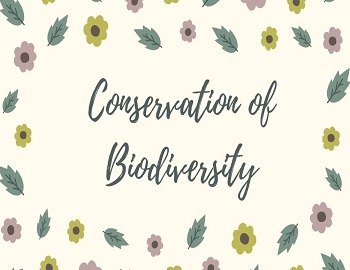Table of Contents
Conservation of Biodiversity:
The enormous value of biodiversity due to their genetic, commercial, medical, aesthetic, ecological and optional importance emphasizes the need to conserve biodiversity. Gradually we are coming to realize that wildlife is not just ‘a game to be hunted’, rather it is a ‘gift of nature’ to be nurtured and enjoyed. A number of measures are now being taken the world over to conserve biodiversity including plants and wildlife.
Biodiversity conservation is defined as the management of human use of the biosphere so that it may yield the greatest sustainable benefit to the present generation while maintaining its potential to meet the needs and aspirations of future generations.
Conservation of biodiversity has the following three specific objectives-
- To maintain essential ecological processes and life-supporting systems.
- To preserve the diversity of species or the range of genetic material found in the organisms on the planet.
- To ensure sustainable utilization of species and ecosystems which support millions of rural communities as well as the major industries all over the world.
There are two approaches of biodiversity conservation i.e. in-situ and ex-situ conservation.
In-situ conservation:
In-situ means ‘on site’, hence in-situ conservation is the conservation of species diversity within normal and natural habitats and ecosystems. In-situ conservation refers to the conservation of habitats, species and ecosystems where they naturally occur. During in-situ conservation, the natural processes and interaction are conserved as well as the elements of biodiversity. Example- Biosphere Reserves, National Parks, Sanctuaries, Reserve Forests etc.
National Park:
- A National Park is an area dedicated for the conservation of wildlife along with its environment.
- It is also meant for enjoyment through tourism but without impairing the environment.
- Grazing of domestic animals, all private rights and forestry activities are prohibited within a National Park.
- Each National Park usually aims at conservation specifically of some particular species of wildlife along with others.
- India’s first national park was established in 1936 as Hailey National Park, now known as Jim Corbett National Park, Uttarakhand.
Wildlife Sanctuaries:
- Wildlife sanctuaries are also protected areas where killing, hunting, shooting or capturing of wildlife is prohibited except under the control of the highest authority.
- However, private ownership rights are permissible and forestry operations are also permitted to an extent that they do not affect the wildlife adversely.
Biosphere Reserves:
- A Biosphere Reserve is a unique and representative ecosystem of terrestrial and coastal areas that are internationally recognized within the framework of UNESCO’s Man and Biosphere (MAB) Programme.
- The MAB was launched in 1971 to catalyze a greater understanding and provision of knowledge and skills to support sustainable relationships between people and their environment.
- The purpose of the formation of the biosphere reserve is to conserve in-situ all forms of life, along with its support system, in its totality, so that it could serve as a referral system for monitoring and evaluating changes in natural ecosystems.
The main objectives of biosphere reserve programme are to-
- Conserve representative samples of ecosystems (i.e., conservation of biotic diversity for ecological evidence).
- Provide long term in-situ conservation of genetic diversity.
- Provide natural areas for basic and applied research in ecology and environmental biology.
- Impart opportunities for environmental education and training.
- Promote appropriate sustainable management of natural resources.
- Dissemination of experience so as to promote sustainable development elsewhere.
- Biosphere management mandates people’s participation in the conservation of natural resources and shopping of the national landscape.
- In a Biosphere Reserve, the land is designated into different zones, these are the core zone ( where no human activity is allowed), the buffer zone ( where limited human activity is allowed), and the manipulation zone (where a large number of human activity may go on).
- Nilgiri is the first biosphere reserve of India established in 1986.
- Biosphere Reserves have the following functions:
- Helpful in the conservation of ecosystems, species, and other resources.
- Helpful in the promotion of economic development.
- Helpful in promoting scientific research and development.
Ex-situ conservation:
In ex-situ conservation, the biodiversity is conserved out of their natural habitats. Example- Zoos, botanical gardens, seed banks, gene banks, culture collections etc.
Botanical Gardens:
These are the specialized gardens where collections of living plants are maintained for reference purpose. Plant species in these gardens are grown for identification purpose and then each plant is labelled indicating its botanical/scientific name and its family. They play an important role in the conservation of plant species. There are several instances where plants believed to be extinct were found living only in a botanical garden. Example- Sophora toromiro. The Botanical Survey of India (BSI) with its main botanic garden at Sibpur and the regional experimental garden established at different places to suit the acclimatization of plants occurring in different ecological conditions in the country have in their holding rare, endemic and threatened plants. Records of threatened plants that are in cultivation have been kept in Green Books. The Indian Green Book prepared by BSI lists 10 such species which are rare, endangered or endemic but all of which are growing in living state in some botanical gardens of BSI in the country. Currently, botanical gardens have assumed a special role as centres where active research and action-oriented plan for conservation can be developed.
Seed Banks:
The seed bank is an excellent method of conserving diversity. The seeds have to stored under minimal life so that they can be kept for several years without accumulations of mutations and with a minimum loss of viability. Such sort of conservation is practised with the help of cold storage in seed banks where seeds are stored for a long duration. National Bureau of Plant Genetic Resources (NBPGR) is located in New Delhi. Here agricultural and horticultural crops and their wild relatives are preserved by cryopreservation of seeds, pollen etc. by using liquid nitrogen at a temperature as low as -196°C. Varieties of rice, pearl millet, Brassica, turnip, radish, tomato, onion, carrot, chilli, tobacco, poppy etc. have been preserved successfully in liquid nitrogen for several years without losing seed viability.
Tissue Culture:
It is the best method of preservation of genes through the establishment of tissue banks. The tissue culture technique can be extended to endangered species or for those which may otherwise require very varied climate conditions and can be maintained at one place in aseptic cultures. The advantage of this technique are economy of space, relatively low maintenance cost, protection of genotypes from natural calamities and diseases if growing in an open and easy international exchange of healthy stock. National Facility for Plant Tissue Culture Repository (NFPTCR) for the development of a facility for the conservation of varieties of crop plants/trees by tissue culture. This facility has been created within the NBPGR.









Comments (No)